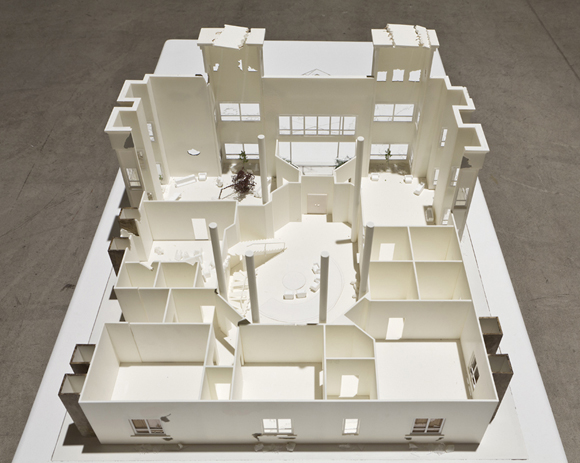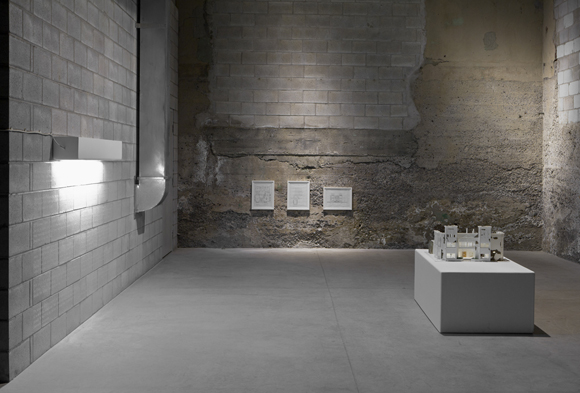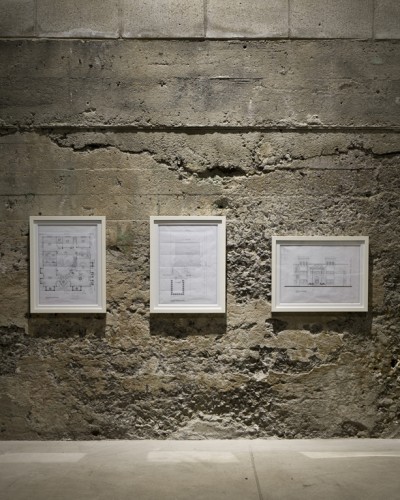
Haig Aivazian, Collapsing Foundations, 2010-Ongoing. Courtesy the artist and Parisian Laundry
Beirut-born, NY-based artist and curator Haig Aivazian is now showing his ongoing project at Parisian Laundry’s bunker space. “Collapsing Foundations†is a multi-part project comprised of written text, sculpture, drawing, video and a lecture performance, all of which seek to answer the following question: Can one erect a monument to an individual who has already erased the traces of his life’s work? Initiated from the CAD drawings of the artist’s late architect father, Aivazian here evaluates the potentials of languages and materiality, examines the notion of legacy and explores the relationships between private and public, through a wider body of research and various forms of presentations. M-KOS interviewed Aivazian during the opening of his exhibition.
M-KOS [MKOS]: How did “Collapsing Foundations†start off?
Haig Aivazian [HA]: I’ve been thinking about this project for several years now. Initially it was a fairly academic paper that I wrote. I had these drawings my father had done that I needed to do something with. I knew there was a potential in them but I wasn’t quite sure what to do with them. I wanted to explore the lines, explore them almost formally. I was thinking about drawing parallels between the collapse of a building and the collapse of a body, but mostly I was interested in the collapse of language in these moments: At the approach of death, what happens to language? What happens when we speak? What is our relationship to death as we speak? So I got interested in this idea of the very act of speaking, as an effort to ward off death. But the more we spoke, the more we are approaching death. So those are some of the ideas at the beginning point.
MKOS: And this was after your father’s death?
HA: Yes. I remember I was there at the hospital when the drawings were being done and I forgot about them for a while because at the time I found them kind of normal. When I came across them again I remembered that moment and I thought that it was important to do something with them. And to do something with them, not as an act of memorializing it all, it wasn’t a matter of preserving something but on the contrary the idea was to question the notion of legacy, by looking at the drawings as if they were the act of an architect taking away his own legacy. So I like the idea of sabotage, and again the parallel between sabotaging a building and sabotaging one’s own body as a way of taking agency over it.
MKOS: How has this project been developing over time?
HA: I teased out the ideas, initially as a written text. I often work with text as a departure point. I did all the research and I let it go for a while and I did a shorter version of the text as an article. The original text was about 2,000 words and I brought it down to 800 words. Then I went back to the drawings, and forgot about the text. And then I started exploring. I went to the cemetery and did some video works. So there are multiple parts to the project, the writing is one part, the installation is another part and the lecture / performance is another part as well.
MKOS: That’s the performance you are doing here next week?*
HA: Yes. It’s called “The Wolf at Your Door Step†It is a lecture performance which begins as a traditional artist talk and starts from the installation and conversations around the installation. The title comes from a comment somebody made about the maquette.

Collapsing Foundations, installation view at Parisian Laundry 2012. Courtesy the artist and Parisian Laundry
MKOS: This is a project that you started from your very personal story, which you are now putting into the public realm of a gallery. How did the project transit between these private and public spheres?
HA: From the beginning it was very important for me to use a personal story as a means to talk about something larger. I often work in this way where I will look into a larger historical occurrence and intertwine it with more personal occurrences, drawing parallels between the macro and micro narratives, and how those things weave together. So, it’s not a project about the celebration of a person or a memorial but about the intensity of the episode that I am describing is a channel to talk about these other notions. And the lecture aspect of it goes more into attempts at constructing of the biography of the architect but again the very format of the lecture falls apart. It’s the impossibility of language to grasp what death is, or to grasp even what life is, or to grasp subjectivity. It’s more these larger issues that I’m interested in and I just think that these drawings are really powerful tools to begin that conversation.
MKOS: Your performances are or have been presumably staged in different social context, as a part of this bigger project, how do you plan to integrate all these elements into one piece?
HA: I haven’t thought about it yet. I think it’s definitely true that every time I’ve done the lecture – three so far – each time it has been in a very different context so the reception has been very different. Generally I don’t get a lot of feedback about it, it gets a lot of silence at the end [Laugh], which is fine. I’m interested in the kind of discomfort that my vulnerability in the lecture creates. As for the larger project, I don’t know if I want to collect this data in very linear way. For sure, there are things that are brewing in my head as I’m collecting these thoughts and sketches, but I am happy to keep the material and research that is not in the first two parts of the project fragmented for now. I’m not sure how these components are actually feeding into the final result. It’s a slow process and I think there’ll be one more part of the project and I don’t anticipate there being many more. I’m not sure what that’s going to be. It could be video, some sketches, a publication, I don’t know yet.
MKOS: The title “Collapsing†suggests that things are in mid-process.
HA: Absolutely.
MKOS: At what point would you decide to end this ongoing project?
HA: I’ve given myself an assignment, essentially. And each part of the project is research towards that assignment. But if I were to think about decoding the moments of these drawings, there could be endless interpretations that I could bring into it. I choose to highlight this idea of sabotage as the one predominant interpretation, with the knowledge that there is no answer to this investigation. Someone said about my work: “you never get all of the suspects in one room and find the answer”. You can endlessly interpret these actions. But the assignment I set for myself is an assignment that my mother had given me in life and that was to come up with a design for the tombstone for my father, who is buried in Lebanon. The tomb currently is unmarked. So that was really the departure point for me: To start thinking about how I even do that, or what a tombstone is, what does one put on it. This is why I started looking back to these drawings and trying to see if I could tease out some materiality from these marks and start thinking about a vocabulary of materials, to potentially think about the possibility of a tombstone. Can I make a tombstone? What does it mean if an architect erased all of his material marks as an architect, how do I then reassign materiality after that act, to a structure meant to represent him, is that possible? Or more importantly, is that ethical?
MKOS: I hope the project takes you to the point where you can eventually make your father’s tombstone.
HA: Thanks! Often people talk to me from an emotional standpoint, which is fine and of course it’s an important component. But I think there is also bitterness and a questioning of the manner in which we hold on to a person and how we force a specific shape on a subject that has lost that shape, this very idea of a tombstone being this permanent mark of somebody’s passage. Often they’ll have one brief sentence meant to define the deceased’s lifespan, so there is a resistance to this manner of memorializing in the work as well.

Collapsing Foundations, installation view at Parisian Laundry 2012. Courtesy the artist and Parisian Laundry
MKOS: Do you feel that, the longer you go on with this project, the more you will feel detached from your original point of departure, are becoming more objective?
HA: I am not so interested in whether I remain attached or become detached from the initial intensity of the work. But definitely, the longer I go on, the more my initial assignment seems impossible, there’s nothing to be materialized. There is no meaning in death. If you think of a tombstone as a mini-monument, the monument can never be a human, it can only be ideology, and the space between ideology and humanity can never be bridged. Or at least I haven’t found a way to do it so far.
MKOS: You are also a curator and have done a number of projects. Do your artistic and curatorial practices feed off each other?
HA: In many ways they are very different and when I first started working on curatorial projects, I made sure that it stayed absolutely separate from my practice as an artist, and they do stay separate for the most part. But the realization that I’ve come to is that they do in some ways overlap. Not so much in the subject matter, or the outlets, but more just in methodology, meaning that the way that I structure exhibitions and the way I structure my own projects have some similarities. There is a logic of folders and sub folders that somehow apply in both. I have however managed to compartmentalized my brain to go back and forth between these two roles without too much cross contamination.
MKOS: And what is your next project?
HA: I’m not sure. I have several projects that I’m working on, that have ongoing components. As I said I work in multi-parts, in folders and sub-folders. I’m at a place where I have recently completed fairly large projects including one on the Burj Khalifa, the world’s tallest tower, entitled The Unimaginable Things We Build, and I am torn between going back to other ongoing projects and adding to them or starting new lines of research. I don’t really have anything new formulated at this moment. I have however been thinking a lot, with this interest in the private and the public, about sex scandals. Dominique Strauss-Kahn in particular is a figure that I want to look into and see what sort of complications arise from looking into this “bad guy” figure. I want to see if there are ways to dissect that figure and all the problematics of that figure, without the comfortable distance that a moralistic media places between the rest of society and these sorts of offenders. What does it mean to have these people embody all of the evils of society which we can simply place on them, without a questioning of the structures that allow for these sorts of figures of power to emerge, to abuse, to assault… And how do we then consume that assault? How do we negotiate those evils within our own persons? I am not interested in normalizing this sort of violence by saying it is in society or in all of us, but I want to start by doing away with the comfortable distance and see if something more complicated emerges about how society visualizes, discusses and consumes these events. I haven’t really began my research at all but the affair has been a recurring thought to me. It’s an idea that I have had a hard time shaking off so I’m going to have to look into it sooner or later. â–
Interviewed by Miwa Kojima
* Aivazian did his lecture performance “The Wolf at Your Door Step” on 4th April 2012 at Parisian Laundry.
Haig Aivazian is an artist, curator and writer born in Lebanon and currently based in New York City. Using performance, video, installation and sculpture, his work weaves together personal and geo-political, micro and macro narratives as it searches for ideological loopholes and short circuits. The result is a set of elaborate and layered narratives that draw parallels between seemingly unrelated events –between the invisible and the over visualized, the historical and the undocumented— in order to unearth underlying mechanisms of how histories are told. Aivazian has a BFA from Concordia University in Montréal Canada and an MFA from Northwestern University in Chicago, USA. He also attended Skowhegan School of Painting and Sculpture in 2011. He has been involved in a number of curatorial initiatives including Roads Were Open / Roads Were Closed at The Third Line gallery in Dubai (2008) and was the Associate Curator of the 10th edition of the Sharjah Biennial in 2011 entitled Plot for a Biennial. His work has been shown in France, Canada, the UAE and the United States, and the first installment of his ongoing project entitled FUGERE (A Series of Olympiadic Events) was commissioned and exhibited in the 9th edition of the Sharjah Biennial (2009). Aivazian has written for a number of websites and publications including Bidoun, FUSE, AdBusters, Ibraaz.org, AMCA, The Arab Studies Journal as well as several exhibition catalogues. He is currently represented by Lombard Freid Projects in New York.
Artist’s website: haigaivazian.com
Haig Aivazian
Collapsing Foundations
30 March – 28 April 2012
Parisian Laundry
3550 St-Antoine West
Montréal, QC
H4C 1A9 Canada
www.parisianlaundry.com
